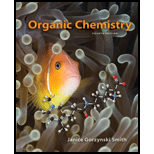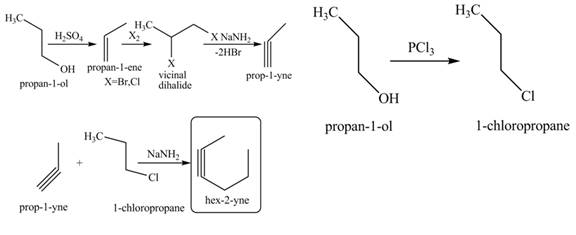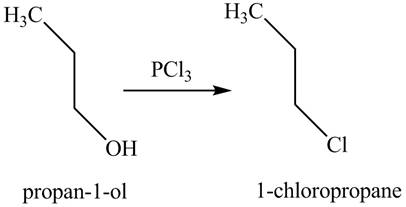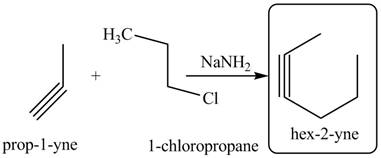
Concept explainers
Devise a synthesis of each compound using
(a)
Interpretation: A synthesis of
Concept introduction: The replacement or substitution of one functional group with another different functional group in any chemical reaction is termed as substitution reaction. The nucleophilic reaction that consists of bimolecular as well as bond-making and bond-breaking steps is termed as
Answer to Problem 11.60P
A synthesis of

Explanation of Solution
The first step of the synthesis of

Figure 1
In this step, the starting organic material
The second step of the synthesis of

Figure 2
In this step, the starting organic material
The third step of the synthesis of

Figure 3
In this step, the intermediates,
A synthesis of
(b)
Interpretation: A synthesis of
Concept introduction: The replacement or substitution of one functional group with another different functional group in any chemical reaction is termed as substitution reaction. The nucleophilic reaction that consists of bimolecular as well as bond-making and bond-breaking steps is termed as
Answer to Problem 11.60P
A synthesis of

Explanation of Solution
The first step of the synthesis of

Figure 4
In this step, the starting organic material
The second step of the synthesis of

Figure 5
In this step, the starting organic material
The third step of the synthesis of

Figure 6
In this step, the intermediates,
A synthesis of
Want to see more full solutions like this?
Chapter 11 Solutions
Connect Access Card For Organic Chemistry
Additional Science Textbook Solutions
Chemistry
Chemistry: The Central Science (13th Edition)
Chemistry In Context
Organic Chemistry (9th Edition)
- Devise a synthesis of (E)-tetradec-11-enal, a sex pheromone of the spruce budworm, a pest that destroys fir and spruce forests, from acetylene, Br(CH2)10OH, and any needed organic compounds or inorganic reagents.arrow_forward2. provide appropriate reagentsarrow_forwardDraw the products formed when phenol(C6H5OH) is treated with each reagent. Give an explanation. a. HNO3, H2SO4 h. product in (a), then Sn, HClarrow_forward
- Devise a synthesis of each compound from CH3CH2CH2CO2Et, benzene, and alcohols having ≤ 2 C's. You may also use any required organic or inorganic reagents.arrow_forwardIbufenac, a para-disubstituted arene with the structure HO2CCH2C6H4CH2CH(CH3)2, is a much more potent analgesic than aspirin, but it was never sold commercially because it caused liver toxicity in some clinical trials. Devise a synthesis of ibufenac from benzene and organic halides having fewer than five carbons.arrow_forwardDevise a synthesis of (E)-tetradec-11-enal, a sex pheromone of thespruce budworm, a pest that destroys fir and spruce forests, fromacetylene, Br(CH2)10OH, and any needed organic compounds orinorganic reagents.arrow_forward
- Oximene and myrcene, two hydrocarbons isolated from alfalfa that have the molecular formula C10H16, both yield 2,6- dimethyloctane when treated with H2 and a Pd catalyst. Ozonolysis of oximene forms (CH3)2C = O, CH2 = O, CH2(CHO)2, and CH3COCHO. Ozonolysis of myrcene yields (CH3)2C = O, CH2 = O, (two equiv), and HCOCH2CH2COCHO. Identify the structures of oximene and myrcene.arrow_forwardSynthesize each compound from benzene, organic halides with < 5 C's, and any other organic or inorganic reagents.arrow_forwardAn alkene is treated with OsO4 followed by H2O2. When the resulting diol is treated with HIO4, the only product obtained is an unsubstituted cyclic ketone with molecular formula C6H10O. What is the structure of the alkene?arrow_forward
- Devise a synthesis of (E)-tetradec-11-enal, a sex pheromone of the spruce budworm, a pest that destroys r and spruce forests, from acetylene, Br(CH2)10OH, and any needed organic compounds or inorganic reagents.arrow_forwardA synthetic organic molecule, G, which contains both aldehyde and ether functional groups, is subjected to a series of reactions in a multi-step synthesis pathway. In the first step, G undergoes a Wittig reaction, leading to the formation of an alkene, H. Subsequently, H is treated with an ozone (O3) reagent followed by a reducing agent in an ozonolysis reaction, resulting in the formation of two different products, I and J. Considering the functional groups present in G and the nature of the reactions involved, what are the most probable structures or functional groups present in products I and J? A. I contains a carboxylic acid group, and J contains an aldehyde group. B. I contains a ketone group, and J contains an alcohol group. C. I and J both contain aldehyde groups. D. I contains an ester group, and J contains a ketone group. Don't use chat gpt.arrow_forwardDraw the products formed when p-methylaniline (p-CH3C6H4NH2) is treated with each reagent. a. HCl b. CH3COCl c. (CH3CO)2O d. excess CH3I e. (CH3)2C = O f. CH3COCl, AlCl3 g. CH3CO2H h. NaNO2, HCl i. Part (b), then CH3COCl, AlCl j. CH3CHO, NaBH3CNarrow_forward

 Organic ChemistryChemistryISBN:9781305580350Author:William H. Brown, Brent L. Iverson, Eric Anslyn, Christopher S. FootePublisher:Cengage Learning
Organic ChemistryChemistryISBN:9781305580350Author:William H. Brown, Brent L. Iverson, Eric Anslyn, Christopher S. FootePublisher:Cengage Learning

